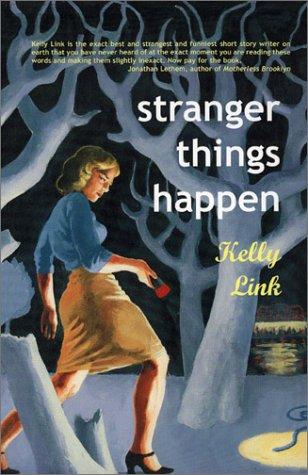In many ways, Kelly Link's "Stranger Things Happen" defies neat categorization within a single genre. Many of the elements that make up the story are hard to pinpoint, and attempting to pigeonhole her within a single category can be quite limiting. Below are three genre categories a reader might associate with Kelly Link. Keep in mind, however, that none of these apply absolutely. Read with a grain of salt and come to your own conclusions.
-------
FABLES AND FAIRY-TALES
A fairy tale or fairy story is a fictional story that usually features folkloric characters (such as fairies, goblins, elves, trolls, witches, giants, and talking animals) and enchantments, often involving a far-fetched sequence of events. In modern-day parlance, the term is also used to describe to something blessed with unusual happiness, as in "fairy tale ending" (a happy ending) or "fairy tale romance", though not all fairy tales end happily. Colloquially, a "fairy tale" or "fairy story" can also mean any far-fetched story.
In cultures where demons and witches are perceived as real, fairy tales may merge into legendary narratives, where the context is perceived by teller and hearers as having historical actuality. However, unlike legends and epics, they usually do not contain more than superficial references to religion and actual places, persons, and events; they take place "once upon a time" rather than in actual times.
The history of the fairy tale is particularly difficult to trace, because only the literary forms can survive. Still, the evidence of literary works at least indicates that fairy tales have existed for thousands of years, although not perhaps recognized as a genre; the name "fairy tale" was first ascribed to them by Madame d'Aulnoy. Literary fairy tales are found over the centuries throughout the world, and when folklorists collected them, they found fairy tales in every culture. Fairy tales, and works derived from fairy tales, are still written today.
The older fairy tales were intended for an audience of adults as well as children, but they were associated with children as early as the writings of the précieuses; the Brothers Grimm titled their collection Children's and Household Tales, and the link with children has only grown stronger with time.
Folklorists have classified fairy tales in various ways. Among the most notable are the Aarne-Thompson classification system , and the morphological analysis of Vladimir Propp. Other folklorists have interpreted the tales' significance, but no school has been definitively established for the meaning of the tales.
GOTHIC LITERATURE
Gothic fiction is an important genre of literature that combines elements of both horror and romance. As a genre, it is generally believed to have been invented by the English author Horace Walpole, with his 1764 novel The Castle of Otranto. The effect of Gothic fiction depends on a pleasing sort of terror, an extension of essentially Romantic literary pleasures that were relatively new at the time of Walpole's novel.
Prominent features of Gothic fiction include terror (both psychological and physical), mystery, the supernatural, ghosts, haunted houses and Gothic architecture, castles, darkness, death, decay, doubles, madness, secrets and hereditary curses.
The stock characters of Gothic fiction include tyrants, villains, bandits, maniacs, Byronic heroes, persecuted maidens, femmes fatale, madwomen, magicians, vampires, werewolves, monsters, demons, revenants, ghosts, perambulating skeletons, the Wandering Jew and the Devil himself.
Important ideas concerning and regarding the Gothic include: Anti-Catholicism, especially criticism of Roman Catholic excesses such as the Inquisition (in southern European countries such as Italy and Spain); romanticism of an ancient Medieval past; melodrama; and parody (including self-parody).
SPECULATIVE FICTION
Speculative fiction is a term which has been used in multiple related but distinct ways. Speculative fiction is a type of fiction that asks the classic "What if?" question and attempts to answer it.
In some contexts, it has been used as an inclusive term covering a group of fiction genres that speculate about worlds that are unlike the real world in various important ways. In these contexts, it generally includes science fiction, fantasy, horror fiction, supernatural fiction, superhero fiction, alternate history, and magic realism. The term is used this way in academic and ideological criticism of these genres, as well as by some readers, writers, and editors of these genres. In these contexts, the term does not imply an opinion about the relative merits of any of the genres it includes.
from Wikipedia.org
20080127
Subscribe to:
Post Comments (Atom)

No comments:
Post a Comment